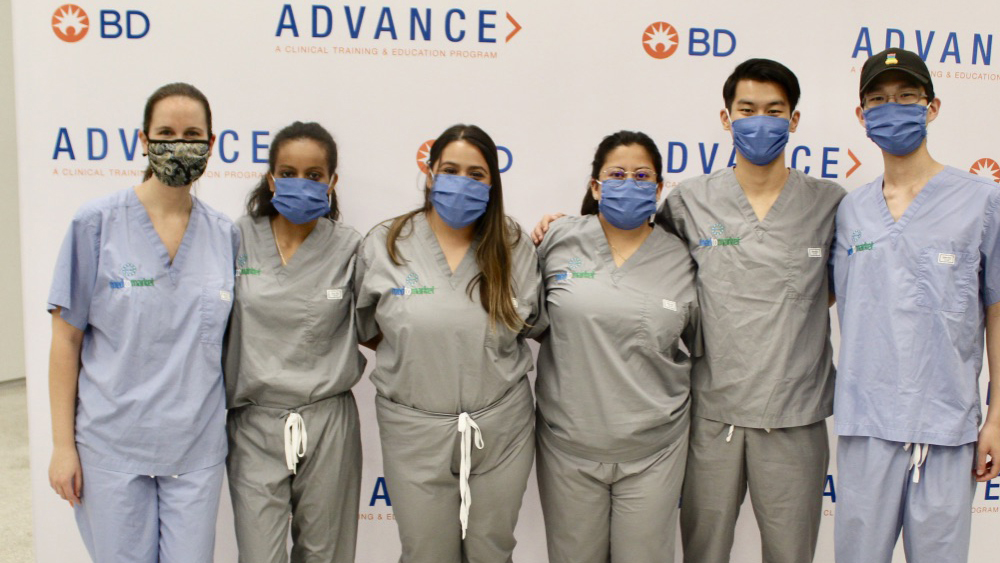
There are about 6.5 million people in the United States who have peripheral artery disease, which causes a narrowing or blockage of the arteries that carry blood to the legs. In extreme cases this disease can progress to critical limb ischemia (CLI), where the restriction in the arteries is so severe that restricted blood flow to tissue causes leg ulcers. CLI is considered deadly unless procedures are done to correct the blood flow restriction. When treatment fails, many of these patients will require amputation if blood flow is not restored to the limbs.
To combat this, a capstone team in the Department of Biomedical Engineering at Texas A&M University designed a more effective way to treat this disease.
“There’s such a large amount of people who are affected in the U.S., this was a really unique project for us to be on because we’re able to create practical solutions and to really get hands-on experience, not only with the machining aspect of creating, but going through the whole design process and making a solution,” said team member Madelynn Gomez.
The team developed a safer and more effective valvulotome, a medical device used for a bypass procedure. The device defunctionalizes the valves in the veins. Valves help assist the flow of blood back to the heart, and by defunctionalizing them, clinicians can increase the flow of blood to the lower limbs and allow the vein to act as a bypass vessel for the clogged artery.
“The problem faced by the marketed valvulotomes is that they are irritating the vein walls and sometimes they don’t catch onto the valves and actually defunctionalize them,” said team member Maraki Samuel. “Our team is trying to solve this problem by designing a valvulotome that is more effective and safer to use by surgeons.”
Over the last two semesters, the team designed and prototyped a valvulotome somewhat modeled off claw machines seen at arcades. The device is run through a catheter delivery system so that it enters the body inside the blood vessel, which makes it a less invasive procedure. The claw can fit into the cusp shape of the valves and its shape will provide a better guarantee that the device will defunctionalize the vein, reducing the chances of blood clotting in the bypass segment.
By making the device safer and more accessible, the team said it could open up applications of it to a wider variety of patients.
Throughout the process, the team faced a series of challenges, from fully grasping the scope of their assignment to experimenting with different design options.
“As for this second semester, the greatest challenge is manufacturing our prototype,” said team member Frida Leon Olmedo. “Initially, we considered using a 3D printer to create a larger scale prototype that would allow for additional testing. But because the 3D printer is a very low fidelity printer, it didn’t really output the prototype as we needed it, so we now have to consider a different type of manufacturing.”
While all team members are biomedical engineering students, their strengths and backgrounds vary. For Michael Rhiew, he originally came to Texas A&M to study chemical engineering, but soon realized he wanted to switch to something involving the medical field.
“My mom is part of biomedical field. It’s a lot of work and a lot of responsibility, but she gets the opportunity to help a lot of people,” Rhiew said. “That really drew me to biomedical engineering and here I am.”
The team’s sponsor was Becton, Dickinson and Company (BD), a medical device company. Olivia Palmer, staff engineer at BD, was the team’s contact for their project. She said she really enjoyed working with the team over the last year.
“I love seeing what they’ve come up with and seeing the creative ideas that they have connected that we just hadn’t even thought of when thinking about this problem,” Palmer said.
The team met virtually with Palmer weekly, and they said they appreciated working with a sponsor willing to have that level of interaction with the team. Team member Christopher Hung said a statement from Palmer early on in the capstone process was key to how they approached the project: “There’s a fine line to walk between theory versus functionality.”
“At the beginning of the semester when we were brainstorming ideas, we had this whirlpool of agency, we could do this that, worrying about so many different concepts,” Hung said. “Having that industry perspective and mentorship really helped us highlight the most important aspects of our medical device and helped us progress forward with our prototype.”